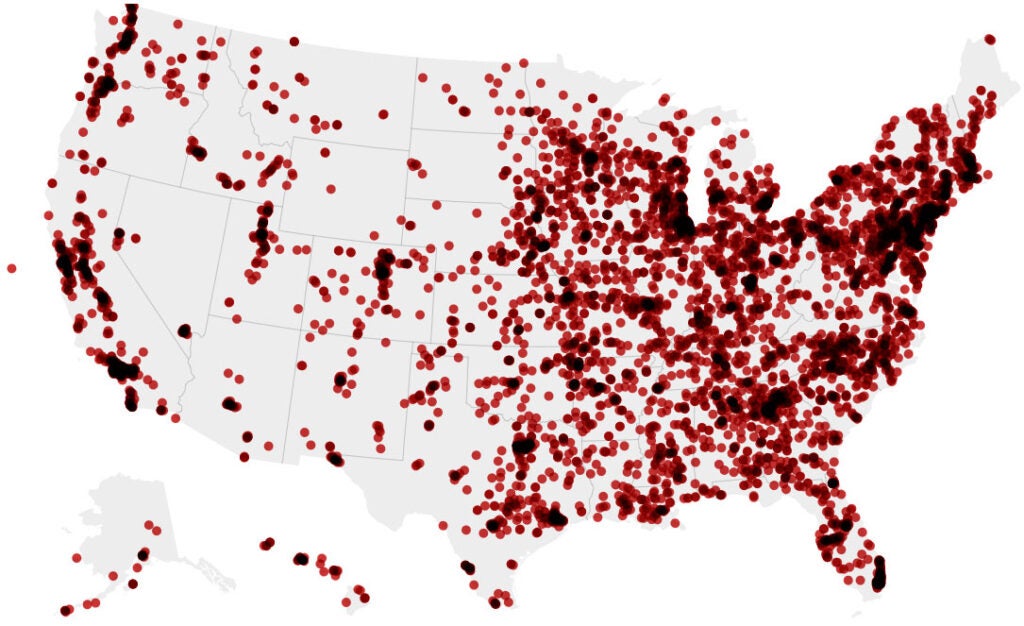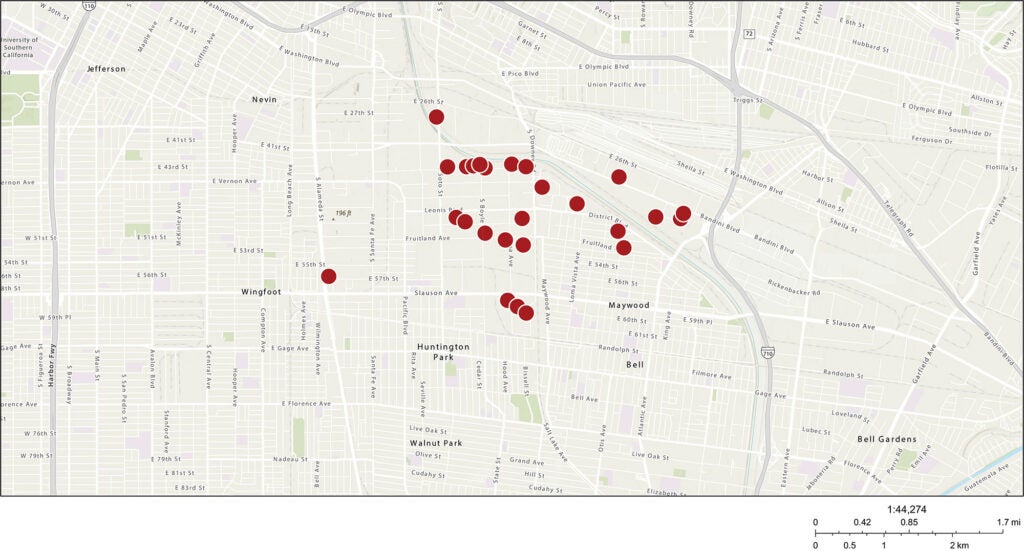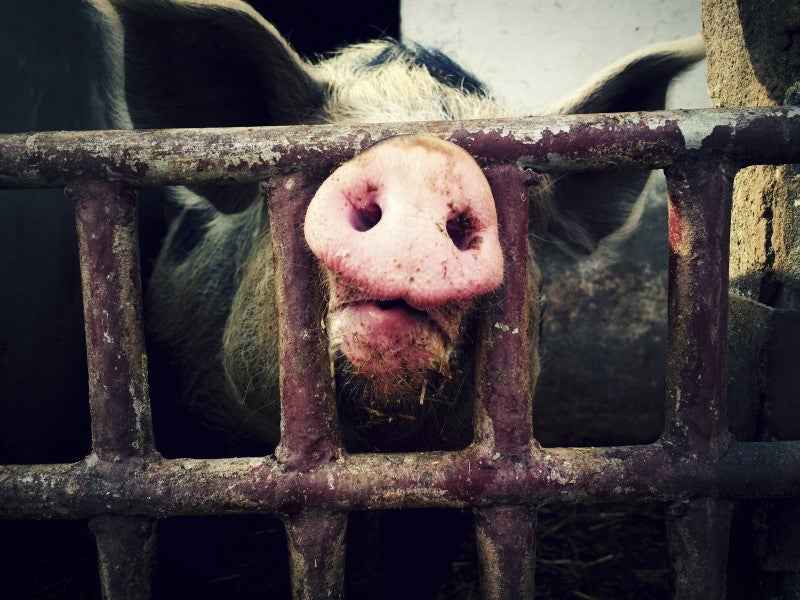We Sued the EPA to Restrict Water Pollution from Slaughterhouses. And We Won.
As a result of our litigation, the EPA agreed to finalize new water pollution control regulations for slaughterhouses and animal rendering facilities by August 2025.
More than 9 billion animals are killed in slaughterhouses across the United States each year—that is, on average, over 17,000 animals per minute. Slaughterhouse byproducts such as fat, bone, blood, and feathers often are sent to animal rendering facilities for conversion into tallow, lard, animal meal, and other products. Both slaughterhouses and rendering facilities require a near-constant flow of water, and they discharge staggering quantities of dangerous and damaging water pollution. Federal regulations restricting this pollution are either out-of-date or non-existent—but thanks to our litigation, that’s about to change.
On May 3, 2023, the U.S. District Court for the District of Columbia approved an agreement we reached with the U.S. Environmental Protection Agency, which requires the EPA to propose new regulations restricting water pollution from slaughterhouses and rendering facilities by December 2023—and to finalize those regulations by August 2025.

The EPA has provided location information for 7,608 slaughterhouses and rendering facilities across the country. Many of these facilities are located in low-communities, communities of color, and under-resourced or over-burdened communities, raising environmental justice concerns.
There’s no question that new regulations are necessary. According to the EPA, slaughterhouses and rendering facilities are the country’s largest industrial source of phosphorus pollution and second largest industrial source of nitrogen pollution. Nitrogen and phosphorus are naturally occurring nutrients necessary for plant growth. But excessive quantities of nitrogen and phosphorus pollution can accumulate in waterways, rendering water unsafe for drinking and unfit for outdoor recreation. Nitrogen and phosphorus pollution also promote harmful algal blooms, which in turn, can cause reductions in oxygen levels as they decompose, resulting in fish kills and other harm to aquatic life. For these reasons, the EPA acknowledges that nitrogen and phosphorus pollution are among the most widespread, costly, and challenging environmental problems affecting water quality in the United States.
In this litigation, we partnered with organizations whose members are directly harmed by water pollution from slaughterhouses and rendering facilities. For instance, the Black Warrior Waterkeeper, told us that he and many of his organization’s members avoid swimming and kayaking in Graves Creek, which receives wastewater from a slaughterhouse in Blountsville, Alabama, for fear of exposure to dangerous levels of bacteria and other pollution—especially after one member got sick after paddling downstream of the slaughterhouse.
Not only does water pollution from slaughterhouses and rendering facilities threaten human health and the environment, but it also exacerbates injustice. We analyzed 184 slaughterhouses and rendering facilities identified by the EPA, all of which discharge pollution directly to rivers and streams, and found that these facilities are disproportionately likely to be located within one mile of communities that the EPA classifies as “low-income” or “linguistically isolated.” Similarly, our analysis of 308 slaughterhouses and rendering facilities that discharge pollution indirectly through sewage treatment plants shows that these facilities tend to be located within one mile of communities classified as “low-income” or “minority.”
To make things worse, slaughterhouses and rendering facilities are often located near additional slaughterhouses, rendering facilities, and concentrated animal feeding operations, commonly known as CAFOs, compounding the risks they pose. For example, according to the EPA, there are at least 27 indirect-discharging slaughterhouses and rendering facilities located in Vernon, California, where more than 90 percent of the population are people of color. And, in Duplin County, North Carolina, the Co-Founder and Executive Director of the Rural Empowerment Association for Community Help—one of our partners in this litigation—lives and works within 3 miles of at least 41 CAFOs, within 20 miles of at least four slaughterhouses and rendering facilities, and less than an hour and a half away from the world’s largest pork slaughterhouse. Slaughterhouses, rendering facilities, and CAFOs discharge many of the same pollutants—and they often are controlled by one of the same small group of major corporations.

Many slaughterhouses and rendering facilities are clustered, compounding the risks they pose to surrounding communities. For example, there are at least 27 indirect-discharging slaughterhouses and rendering facilities located in Vernon, California, where more than 90 percent of the population are people of color.
New regulations restricting water pollution from slaughterhouses and rendering facilities are decades overdue. When it comes to major industries that discharge nitrogen and phosphorus, including slaughterhouses and rendering facilities, the Clean Water Act directs the EPA to establish pollution-limiting regulations that reflect the “best available technology” and to review existing regulations at least annually to ensure they keep pace with technological advances. But the EPA has failed to revise regulations for slaughterhouses and rendering facilities for at least 19 years, notwithstanding its repeated acknowledgment that those regulations fall short of widely available pollution control technology.
Some slaughterhouses and rendering facilities are still subject to outdated and under-protective standards that the EPA promulgated in the mid-1970s. And none of the EPA’s existing regulations limit discharges of phosphorus—even though slaughterhouses and rendering facilities discharge more phosphorus than any other industry. Even more concerning, the EPA has never published national standards applicable to the vast majority of slaughterhouses and rendering facilities, which discharge wastewater through sewage treatment plants, even though the EPA has known for decades that—without adequate pretreatment—pollutants in slaughterhouse wastewater pass through many treatment plants into our nation’s rivers and streams.
The EPA’s obligation to restrict water pollution from slaughterhouses and rendering facilities is clear, but other aspects of industrial agriculture remain exempt from meaningful regulation under our nation’s environmental laws. For instance, the EPA admits that many CAFOs discharge water pollution in violation of federal law and that CAFO pollution worsens environmental injustice, but it maintains that it and state environmental agencies lack the resources necessary to remedy the problem. (We disagree.) CAFOs also emit substantial quantities of toxic air pollutants such as ammonia and hydrogen sulfide, but the EPA does not require them to measure or report these emissions to authorities, as other industrial facilities are required to do. And government decision-makers frequently fail to acknowledge the threats that agriculture poses to our climate, even though it produces more climate-harming methane than U.S. oil and gas sector.
Agriculture is the only highly polluting sector of our economy with so little oversight. Through this litigation and other projects, Earthjustice’s Sustainable Food and Farming Program works to reduce pollution from industrial agriculture and to accelerate the shift to a climate-friendly system that supports farmers, workers, and neighbors.
Together with our co-counsel at the Environmental Integrity Project, and our clients—Cape Fear River Watch, Rural Empowerment Association for Community Help, Waterkeepers Chesapeake, Waterkeeper Alliance, Humane Society of the United States, Food & Water Watch, Environment America, Comite Civico del Valle, Center for Biological Diversity, and Animal Legal Defense Fund—we first challenged the Trump Administration’s decision not to update regulations governing water pollution from slaughterhouses and rendering facilities in 2019. In response to that challenge, the EPA pledged to strengthen its regulations—but it did not commit to a timeline for doing so. We filed a second lawsuit in December 2022 to press the EPA to adopt the current timeline.
Along with our partners, we will comment on the proposed new regulations when they become available, and we will continue to advocate for the protection of our nation’s rivers and streams.
Earthjustice’s Sustainable Food and Farming program aims to make our nation’s food system safer and more climate friendly.
